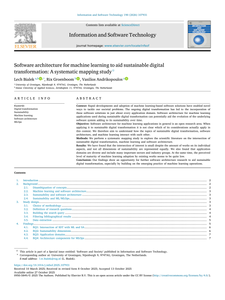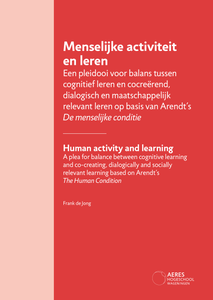Context:Rapid developments and adoption of machine learning-based software solutions have enabled novel ways to tackle our societal problems. The ongoing digital transformation has led to the incorporation of these software solutions in just about every application domain. Software architecture for machine learning applications used during sustainable digital transformation can potentially aid the evolution of the underlying software system adding to its sustainability over time.Objective:Software architecture for machine learning applications in general is an open research area. When applying it to sustainable digital transformation it is not clear which of its considerations actually apply in this context. We therefore aim to understand how the topics of sustainable digital transformation, software architecture, and machine learning interact with each other.Methods:We perform a systematic mapping study to explore the scientific literature on the intersection of sustainable digital transformation, machine learning and software architecture.Results:We have found that the intersection of interest is small despite the amount of works on its individual aspects, and not all dimensions of sustainability are represented equally. We also found that application domains are diverse and include many important sectors and industry groups. At the same time, the perceived level of maturity of machine learning adoption by existing works seems to be quite low.Conclusion:Our findings show an opportunity for further software architecture research to aid sustainable digital transformation, especially by building on the emerging practice of machine learning operations.
DOCUMENT

Human Digital Twins are an emerging type of Digital Twin used in healthcare to provide personalized support. Following this trend, we intend to elevate our virtual fitness coach, a coaching platform using wearable data on physical activity, to the level of a personalized Human Digital Twin. Preliminary investigations revealed a significant difference in performance, as measured by prediction accuracy and F1-score, between the optimal choice of machine learning algorithms for generalized and personalized processing of the available data. Based on these findings, this survey aims to establish the state of the art in the selection and application of machine learning algorithms in Human Digital Twin applications in healthcare. The survey reveals that, unlike general machine learning applications, there is a limited body of literature on optimization and the application of meta-learning in personalized Human Digital Twin solutions. As a conclusion, we provide direction for further research, formulated in the following research question: how can the optimization of human data feature engineering and personalized model selection be achieved in Human Digital Twins and can techniques such as meta-learning be of use in this context?
DOCUMENT
Designing lead-free piezoelectric ceramics with tailored electrical properties remains a critical challenge for various applications. In this paper we present a novel methodology integrating Machine Learning (ML) and optimization procedures to fine-tune electrical properties in lead-free (1-x) Na0.5 Bi0.5 TiO3 - x CaTiO3 piezoelectric ceramics. A comprehensive dataset of dielectric measurements serves as the foundation for training ML models that accurately predict the permittivity (𝜀′) and dielectric loss (tan 𝛿) as functions of Ca2+concentration (x % Ca), temperature and frequency. Two ML techniques are evaluated: random forest regression, and Multi-Layer Perceptron neural network Regression (MLPR). The MLPR model exhibited a superior regression performance, achieving a correlation coefficient of 0.931 and a root mean squared error of 0.029. The MLPR was then optimized by the Non-dominated Sorting Genetic Algorithm II (NSGA-II) to maximizes 𝜀′ while minimizes tan 𝛿. Within the NSGA-II framework, the optimal values were found at the Pareto curve knee, corresponding to a frequency, temperature, and x % Ca of 609.739 kHz, 398.15 K, and 6.10, respectively, resulting in 𝜀′ equal to 857.87 and tan 𝛿 equal to 0.0120. This approach demonstrates the effectiveness of combining ML andoptimization for designing the electrical properties of piezoelectric ceramics, paving the way for more efficient and targeted material development.
DOCUMENT
In this work, a feasible and low-cost approach is proposed for level measurement in multiphase systems inside tanks used for petroleum-derived oil production. The developed level sensor system consisted of light-emitting diodes (LEDs), light-dependent resistor (LDR), and a low-cost microprocessor. Two different types of oil were tested: AW460 and AW68. Linear regression (LR) was applied for 11 scenarios and showed a direct correlation between the level of oil and the sensor’s output. The measurement with AW460 oil presented a perfect linear behavior, while for AW68, a higher standard deviation was obtained justifying the occurrence of the nonlinearity in several scenarios. In order to overcome the nonlinear effect, two machine learning (ML) techniques were tested: K-nearest neighbors regression (KNNR) and multilayer perceptron (MLP) neural network regression. The highest correlation coefficient ( R2 ) and the lowest root mean squared error (RMSE) were obtained for AW68 with MLP. Therefore, MLP was used for regression (level prediction for water, oil, and emulsion) as well as classification (identify the type of oil in the reservoir) simultaneously. The suggested network exhibited a high accuracy for oil identification (99.801%) and improved linear performance in regression ( R2 = 0.9989 and RMSE = 0.065).
DOCUMENT
Routine immunization (RI) of children is the most effective and timely public health intervention for decreasing child mortality rates around the globe. Pakistan being a low-and-middle-income-country (LMIC) has one of the highest child mortality rates in the world occurring mainly due to vaccine-preventable diseases (VPDs). For improving RI coverage, a critical need is to establish potential RI defaulters at an early stage, so that appropriate interventions can be targeted towards such population who are identified to be at risk of missing on their scheduled vaccine uptakes. In this paper, a machine learning (ML) based predictive model has been proposed to predict defaulting and non-defaulting children on upcoming immunization visits and examine the effect of its underlying contributing factors. The predictive model uses data obtained from Paigham-e-Sehat study having immunization records of 3,113 children. The design of predictive model is based on obtaining optimal results across accuracy, specificity, and sensitivity, to ensure model outcomes remain practically relevant to the problem addressed. Further optimization of predictive model is obtained through selection of significant features and removing data bias. Nine machine learning algorithms were applied for prediction of defaulting children for the next immunization visit. The results showed that the random forest model achieves the optimal accuracy of 81.9% with 83.6% sensitivity and 80.3% specificity. The main determinants of vaccination coverage were found to be vaccine coverage at birth, parental education, and socio-economic conditions of the defaulting group. This information can assist relevant policy makers to take proactive and effective measures for developing evidence based targeted and timely interventions for defaulting children.
MULTIFILE

In dit hoofdstuk zijn de ervaringen beschreven die Hogeschool INHolland opdeed met het stimuleren en faciliteren van ‘Visueel Leren’, het gebruik van digitale concept maps. Twee projecten met concept maps van de Digitale Universiteit (DU), een samenwerkingsverband tussen tien universiteiten en hogescholen, vormden de start.
DOCUMENT

Doel van onderzoek is herontwerpen en testen van leereenheid Jeugdzorg op basis van inzet ‘samenwerkend leren, ondersteund door technologie’. Ogenschijnlijk is er ‘tevredenheid’ over de uitgevoerde leereenheid waarin studententeams een gezamenlijk product moeten opleveren, maar tegelijkertijd wordt slechts een deel van het onderwerp door studenten onderzocht. Het ‘samenwerkend leren’ is meestal beperkt tot verdelen taken en bijdragen op later moment samenvoegen. Ook worden mogelijkheden voor ondersteuning van het leerproces door technologie niet benut. In een herontwerp kan ‘werkelijk’ samenwerkend leren worden vormgegeven, door technologie ondersteund, met de student in de actieve modus. Hierdoor is het mogelijk om ‘samenwerkend leren’ aan bod te laten komen bij alle genoemde deelaspecten van het onderwerp. Na onderzoek naar het hoe het herontwerp eruit zou moeten zien, werden Moodle, de Teamtester, een samenwerkingscontract en peerreview ingezet. Na de module is gekeken of de gestelde doelen behaald zijn. Over het algemeen werd door zowel studenten als docenten effectievere samenwerking ervaren. De rol van de separaat ingezette onderdelen is ook onderzocht en staat beschreven in dit rapport.
DOCUMENT

Dit is een verkennend onderzoek voor zowel OCW als andere stakeholders. Aan dit onderzoek kunnen geen harde conclusies verbonden worden. Het onderzoek heeft louter de bedoeling te illustreren hoe leren en werken in een turbulente omgeving in de praktijk plaats vindt. Bron: Leren in een turbulente omgeving.
DOCUMENT

Deze afscheidsrede van Frank de Jong verwondert zich over de sterke impact van (directe) instructie in het onderwijs en de daarmee samenhangende gerichtheid op het individuele leren. Om een antwoord te vinden op die verwondering put de rede uit de filosofe Hannah Arendt en haar analyse van de menselijke conditie, de vita activa. Arendt onderscheidt drie menselijke activiteiten: arbeid, werken, spreken en handelen. Arbeid gaat over het voorzien in basisbehoeften en het creëren van een ‘thuis’ met anderen waar het goed toeven is. Werken heeft te maken met het creëren van talen en cultuur en daarmee een kunstmatige wereld. Spreken en handelen omvatten het organiseren van de samenleving en politiek bedrijven. Door het leren en onderwijs te koppelen aan de vita activa komt een beeld naar voren van een onderwijs dat zich voornamelijk richt op arbeid en werken, met een sterke nadruk op (directe) instructie en het aanleren van vaardigheden en kennis. Het spreken en handelen, het ontwikkelen van ideeën en het samenwerken aan een betere wereld, blijven vaak onderbelicht in het onderwijs. Directe instructie mag dan wel efficiënt zijn in het steeds meer geïndustrialiseerde onderwijs met eindtermen en managerial KPI’s, het is niet effectief in het licht van het de totale ontwikkeling als mens. Dit pleit voor meer ruimte te creëren voor idee-ontwikkeling, co-creatie, kennisopbouw en dialoog in het onderwijs. Een onderwijstransitie van een 'belief mode' van leren naar een 'design mode' van leren met de nodige infrastructurele verandering op verschillende niveaus die zo’n transitie vereist. Er is een groeiend bewustwording nodig dat de huidige rol en wijze van leren in het onderwijs en in (school)organisaties onvoldoende bijdraagt aan de oplossingen van de huidige complexe uitdagingen in onze samenleving. Een bredere en diepere benadering van leren in het onderwijs, waarbij niet alleen kennisoverdracht en vaardigheden worden benadrukt, maar ook het ontwikkelen van ideeën, samenwerking en dialoog centraal staan is noodzakelijk, zodat er ruimte is om spreken en handelen te ontwikkelen opdat mensen af en toe uit de rij te stappen om een beter ‘thuis’ te realiseren. Dit doe je niet in je eentje maar in cocreatie met anderen samen en dat moet je (stimu)leren.
DOCUMENT
